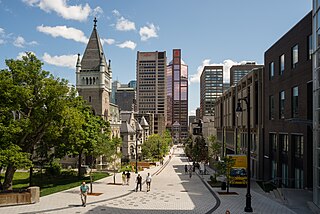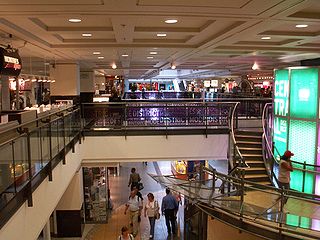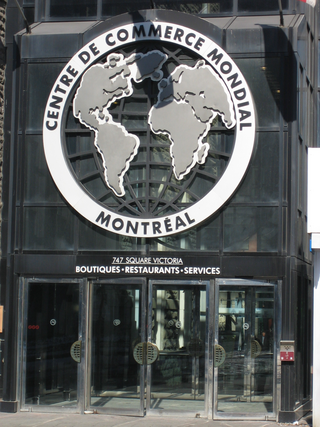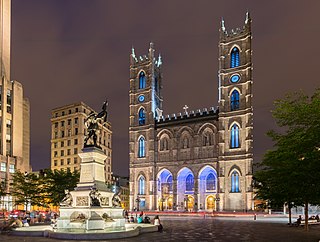
Notre-Dame-de-Grâce, commonly known as NDG, is a residential neighbourhood of Montreal in the city's West End, with a population of 166,520 (2016). An independent municipality until annexed by the City of Montreal in 1910, NDG is today one half of the borough of Côte-des-Neiges–Notre-Dame-de-Grâce. It comprises two wards, Loyola to the west and Notre-Dame-de-Grâce to the east. NDG is bordered by four independent enclaves; its eastern border is shared with the City of Westmount, Quebec, to the north and west it is bordered by the cities of Montreal West, Hampstead and Côte-Saint-Luc. NDG plays a pivotal role in serving as the commercial and cultural hub for Montreal's predominantly English-speaking West End, with Sherbrooke Street West running the length of the community as the main commercial artery. The community is roughly bounded by Claremont Avenue to the east, Côte-Saint-Luc Road to the north, Brock Avenue in the west, and Highway 20 and the Saint-Jacques Escarpment to the south.

Charles Daudelin, was a French Canadian pioneer in modern sculpture and painting. He worked in a wide variety of media, including painting, metal and ceramic sculpture, jewelry, and marionettes which he made with his wife, Louise.

The architecture of Montreal, Quebec, Canada is characterized by the juxtaposition of the old and the new and a wide variety of architectural styles, the legacy of two successive colonizations by the French, the British, and the close presence of modern architecture to the south. Much like Quebec City, the city of Montreal had fortifications, but they were destroyed between 1804 and 1817.

RÉSO, commonly referred to as the Underground City, is the name applied to a series of interconnected office towers, hotels, shopping centres, residential and commercial complexes, convention halls, universities and performing arts venues that form the heart of Montreal's central business district, colloquially referred to as Downtown Montreal. The name refers to the underground connections between the buildings that compose the network, in addition to the network's complete integration with the city's entirely underground rapid transit system, the Montreal Metro. Moreover, the first iteration of the Underground City was developed out of the open pit at the southern entrance to the Mount Royal Tunnel, where Place Ville Marie and Central Station stand today.

Champ-de-Mars station is a Montreal Metro station in the borough of Ville-Marie in Montreal, Quebec, Canada. It is operated by the Société de transport de Montréal (STM) and serves the Orange Line. It is located in Old Montreal by the Champ de Mars park. It opened on October 14, 1966, as part of the original Metro network.

Place-d'Armes station is a Montreal Metro station in the borough of Ville-Marie in Montreal, Quebec, Canada. It is operated by the Société de transport de Montréal (STM) and serves the Orange Line. It is located in Old Montreal.

Lucien-L'Allier station is a Montreal Metro station in the borough of Ville-Marie in Montreal, Quebec, Canada. It is operated by the Société de transport de Montréal (STM) and serves the Orange Line.

Vendôme station is an intermodal transit station in the borough of Côte-des-Neiges–Notre-Dame-de-Grâce in Montreal, Quebec, Canada, near the town of Westmount in the Westmount Adjacent area of Notre-Dame-de-Grâce that adjoins the Décarie Expressway. It is operated by the Société de transport de Montréal (STM) and serves the Orange Line of the Montreal Metro.

Villa-Maria is a Montreal Metro station in the borough of Côte-des-Neiges–Notre-Dame-de-Grâce in Montreal, Quebec, Canada. It is operated by the Société de transport de Montréal (STM) and serves the Orange Line. It is located in the Westmount Adjacent area of the Notre-Dame-de-Grâce neighbourhood, beside the Décarie Expressway trench.

The Quartier international de Montréal (QIM) or Montreal's International District is a district of the Ville-Marie borough in the city's downtown core of Montreal, Quebec, Canada. It is roughly bordered by René-Levesque Boulevard to the north, Notre-Dame Street to the south, De Bleury/Saint-Pierre Street to the east and Robert-Bourassa Boulevard to the west. The Palais des congrès building lying just east of the district is also usually comprised in it. Constructed dispersedly between 1965 and 1985 in place of older colonial housing blocks, the district underwent major urban renewal as a central business district in 2000–2003.

The five-story Montreal City Hall is the seat of local government in Montreal, Quebec, Canada. It was designed by architects Henri-Maurice Perrault and Alexander Cowper Hutchison, and built between 1872 and 1878 in the Second Empire style. It is located in Old Montreal, between Place Jacques-Cartier and the Champ de Mars, at 275 Notre-Dame Street East. The closest Metro station is Champ-de-Mars, on the Orange Line.

The Spanish and Portuguese Synagogue of Montreal, also known as Shearith Israel, is an Orthodox synagogue, located at 4894 Avenue Saint-Kevin in Snowdon, Montreal, Quebec, Canada. The synagogue is the oldest Jewish congregation in Canada. The congregation traces its history from 1760 and was formally established in 1768. It is affiliated with the Orthodox Union.

John Ostell architect, surveyor and manufacturer, was born in London, England and emigrated to Canada in 1834, where he apprenticed himself to a Montreal surveyor André Trudeau to learn French methods of surveying. In 1837 he married Eleonore Gauvin, a member of a prominent French Catholic family in the city. His marriage ensured entry to French Canadian society, he was appointed diocesan architect for Montreal. In 1849 he formed a partnership with his nephew Henri-Maurice Perrault (1828–1903), this was the formation of one of the first architectural dynasties in Canada.

Place d'Armes is a square of the Old Montreal quarter of Montreal, in Quebec, Canada anchored by a monument in memory of Paul de Chomedey, founder of Montreal. Buildings that surround it include Notre-Dame Basilica, Saint-Sulpice Seminary, New York Life Building, Aldred Building, Bank of Montreal head office and 500 Place D'Armes.

Saint Antoine Street, formerly known as Craig Street, is a street located in Montreal, Quebec, Canada. It runs to the south of Downtown Montreal and north of Old Montreal and Griffintown and Saint-Henri. It crosses the Quartier international de Montréal. Between Atwater Avenue and Greene Avenue, the north side of the street is in Westmount.

Notre-Dame Basilica is a minor basilica of the Catholic Church in the historic Old Montreal district of Montreal in Quebec, Canada. It is located at 110 Notre-Dame Street West, at the corner of Saint Sulpice Street. It is situated next to the Saint-Sulpice Seminary and faces the Place d'Armes square.

500 Place d'Armes is an International style building on the historic Place d'Armes square in Old Montreal quarter of Montreal, Quebec, Canada.

Édifice Ernest-Cormier was the second courthouse in Montreal to bear the name Palais de justice de Montréal. It was built between 1922 and 1926, and designed by architects Louis-Auguste Amos, Charles Jewett Saxe and Ernest Cormier. It was the first major commission for Cormier after his return to Montreal from his studies in Paris. After Cormier's death in 1980, the building was renamed in his honour. It currently houses the Quebec Court of Appeal.

Vieux-Québec–Cap-Blanc–Colline Parlementaire is one of the 35 districts of the City of Quebec, and one of six that are located in the borough of La Cité-Limoilou. The district is the most visited and toured location in the city. It is in this partly fortified area where the Château Frontenac is found, with its large terrace overlooking the city of Lévis, across the Saint Lawrence River. A large concentration of cafes, tourist shops, restaurants, hotels and inns are situated in the district. In its most recent census count in 2016, Statistics Canada reported that the district had a population of 5,770 residents, whom comprise 1.1% of the city's total population.























